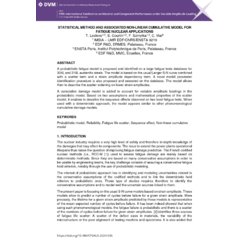- Nur online erhältlich



The nuclear industry requires a very high level of safety and therefore in-depth knowledge of the damages that may affect its components. The issue to extend the power plants operational lifespans thus raises the question of improving fatigue damage prediction.
The French codified nuclear methods used to assess fatigue damage are mainly based on deterministic methods [1]. However, it has been proven that on a macroscopic level, the fatigue process is of an uncertain nature: same load level on fatigue tests can lead to a varying number of cycles before failure [2]. To take into account uncertainties, probabilistic models are developed and can be used to quantify the error margin which cannot be estimated by the deterministic methods.
This study thus aims at…

Datenschutzbedingungen (bearbeiten im Modul "Kundenvorteile")

Lieferbedingungen (bearbeiten im Modul "Kundenvorteile")

Rücksendebedingungen (bearbeiten im Modul "Kundenvorteile")
The nuclear industry requires a very high level of safety and therefore in-depth knowledge of the damages that may affect its components. The issue to extend the power plants operational lifespans thus raises the question of improving fatigue damage prediction.
The French codified nuclear methods used to assess fatigue damage are mainly based on deterministic methods [1]. However, it has been proven that on a macroscopic level, the fatigue process is of an uncertain nature: same load level on fatigue tests can lead to a varying number of cycles before failure [2]. To take into account uncertainties, probabilistic models are developed and can be used to quantify the error margin which cannot be estimated by the deterministic methods.
This study thus aims at developing a probabilistic fatigue model based on a database of fatigue tests. The dataset comprises 130 tests conducted on standardized specimens and on constant amplitude strain-controlled fatigue with a strain ratio of R= -1. They were performed on a large range of strain amplitude (0.15%-1%). In addition, two-level fatigue tests are also used to validate the model on non-linear fatigue damage cumulation.
The proposed model is built on top of a classical Langer fatigue curve summed with an uncertainty term symbolized by an unknown random variable. Similar approaches exist in the literature: in [2], the dependance of the random variable to the strain level is modelized by another independent random variable multiplied by a factor that is a function of the strain level. The novelty of the presented model lies in the use of a partially linear function as the dependance function. Indeed, measurements of the conditional standard deviation indicates that the dispersion of fatigue only varies once the deformation loading is inferior to a given threshold.
A statistical method using the distribution of the deterministic error above and below the threshold is therefore proposed to both calibrate the model parameters and to validate the hypotheses that were used to build the model. The Figure 1 compares the used dataset to the identified model.
To use the model in a reliability analysis, the protocol introduced by [3] is adapted to the studied model. The approach relies on two hypotheses. Firstly, the uncertainty of an experiment only comes from the initial state of the specimen. Secondly, all the fatigue damage applied to the specimen is a deterministic function of the current state of the specimen and of the strain amplitude of the fatigue loading. Combined with the hypotheses, the presence of the dependance function leads to a non-linear cumulative model based on a health decrease concept as shown in Figure 2. The non-linear effects of the resulting model are compatible to phenomenon observed in two-level fatigue tests [4]. The cumulative model is finally tested on the two-level fatigue results.